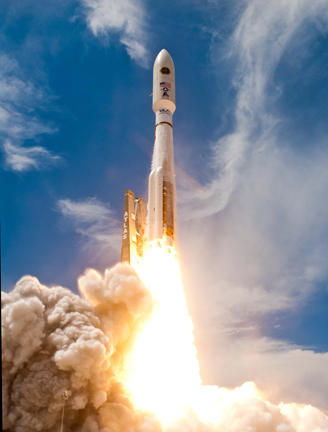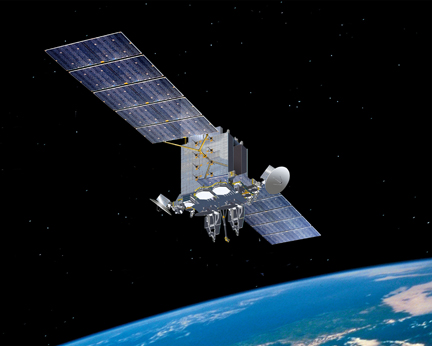Atlas 5 rocket boosts military comsat into space
By WILLIAM HARWOOD
CBS News
KENNEDY SPACE CENTER, FL--A powerful United Launch Alliance Atlas 5 rocket boosted a $1.7 billion military communications satellite into orbit Friday, the second in a planned constellation of advanced relay stations intended to provide secure, jam-resistant command channels even in the extreme environment of a nuclear conflict.
The 197-foot-tall Atlas 5, powered by a Russian-designed RD-180 first stage engine and three solid-fuel strap-on boosters, roared to life and climbed away from launch pad 41 at the Cape Canaveral Air Force Station at 2:42 p.m. EDT (GMT-4), quickly arcing away to the east through a partly cloudy sky.
Liftoff came one day behind schedule because of problems with a valve that prevents the build up of propellant fumes between the rocket's first and second stages. But there were no major problems during Friday's countdown and fourteen minutes after liftoff, the 6.7-ton Advanced Extremely High Frequency -- AEHF-2 -- satellite reached its planned preliminary orbit.
Following a brief coast, the rocket's Centaur second stage engine re-ignited, burning for about five-and-a-half minutes to boost the satellite into a highly elliptical orbit with a planned high point of 31,210 miles and a low point of around 138 miles. The AEHF-2 spacecraft separated from the Centaur stage as planned 51 minutes after liftoff.
Over the next three months or so, flight controllers plan to maneuver the satellite into its final circular orbit 22,300 miles above the equator, using a combination of rocket firings and low-thrust ion propulsion. If all goes well, the Lockheed Martin-built satellite will be turned over to the Air Force for operational use after six months of testing and checkout.
"The primary purpose of the system is so our national command authorities, the senior decision leadership, have the ability to communicate in a nuclear environment," Dave Madden, director of the Military Satellite Communications Systems Directorate at the Air Force's Space and Missile Systems Center, told reporters during a briefing.
"This system will give them the capability to communicate in all environments all the way up through theater nuclear war. That's really what this is all about, so our leadership can have positive control of forces."
The Air Force plans to launch at least six AEHF satellites over the next six years to provide a globe-spanning high-speed communications network that will eventually replace a constellation of five aging Milstar relay stations.
"This system is integral to our national security space architecture," said John Miyamoto, Lockheed Martin's vice president for advanced programs in its Global Communications Systems. "It provides significantly improved protected communications capabilities for both tactical and strategic users. With the addition of a second AEHF satellite in the constellation, the nation will have a robust and resilient seven-satellite combined Milstar-AEHF constellation that will add significant protected communications capabilities."
The Air Force Military Satellite Communications Systems Directorate hopes the second satellite in the AEHF series will avoid the propulsion problems that almost derailed the first mission.
The liquid-fueled thrusters used by the AEHF-1 satellite failed to work properly, presumably because of an obstruction of some sort in the propellant system. Flight controllers were able to save the satellite using its extremely low-thrust Hall current ion thrusters, carrying out more than 500 maneuvers over 14 months to boost the spacecraft to its operational orbit.
"Between X-rays and examination and flow tests, we've checked out the propulsion system, both fuel and oxidizer, so we have extremely high confidence problem we will never see this problem again," Madden said.
The Air Force plans to launch the AEHF-3 satellite in September 2013, with AEHF-4, 5 and 6 following suit in 2016, 2017 and 2018 respectively.
CBS News
 |
| A United Launch Alliance Atlas 5 rocket blasted off Friday from Cape Canaveral Friday, boosting a military communications satellite into space. (Credit: United Launch Alliance) |
The 197-foot-tall Atlas 5, powered by a Russian-designed RD-180 first stage engine and three solid-fuel strap-on boosters, roared to life and climbed away from launch pad 41 at the Cape Canaveral Air Force Station at 2:42 p.m. EDT (GMT-4), quickly arcing away to the east through a partly cloudy sky.
Liftoff came one day behind schedule because of problems with a valve that prevents the build up of propellant fumes between the rocket's first and second stages. But there were no major problems during Friday's countdown and fourteen minutes after liftoff, the 6.7-ton Advanced Extremely High Frequency -- AEHF-2 -- satellite reached its planned preliminary orbit.
Following a brief coast, the rocket's Centaur second stage engine re-ignited, burning for about five-and-a-half minutes to boost the satellite into a highly elliptical orbit with a planned high point of 31,210 miles and a low point of around 138 miles. The AEHF-2 spacecraft separated from the Centaur stage as planned 51 minutes after liftoff.
Over the next three months or so, flight controllers plan to maneuver the satellite into its final circular orbit 22,300 miles above the equator, using a combination of rocket firings and low-thrust ion propulsion. If all goes well, the Lockheed Martin-built satellite will be turned over to the Air Force for operational use after six months of testing and checkout.
"The primary purpose of the system is so our national command authorities, the senior decision leadership, have the ability to communicate in a nuclear environment," Dave Madden, director of the Military Satellite Communications Systems Directorate at the Air Force's Space and Missile Systems Center, told reporters during a briefing.
"This system will give them the capability to communicate in all environments all the way up through theater nuclear war. That's really what this is all about, so our leadership can have positive control of forces."
 |
| A computer graphic showing an Advanced Extremely High Frequency communications satellite in orbit. (Credit: Lockheed Martin) |
"This system is integral to our national security space architecture," said John Miyamoto, Lockheed Martin's vice president for advanced programs in its Global Communications Systems. "It provides significantly improved protected communications capabilities for both tactical and strategic users. With the addition of a second AEHF satellite in the constellation, the nation will have a robust and resilient seven-satellite combined Milstar-AEHF constellation that will add significant protected communications capabilities."
The Air Force Military Satellite Communications Systems Directorate hopes the second satellite in the AEHF series will avoid the propulsion problems that almost derailed the first mission.
The liquid-fueled thrusters used by the AEHF-1 satellite failed to work properly, presumably because of an obstruction of some sort in the propellant system. Flight controllers were able to save the satellite using its extremely low-thrust Hall current ion thrusters, carrying out more than 500 maneuvers over 14 months to boost the spacecraft to its operational orbit.
"Between X-rays and examination and flow tests, we've checked out the propulsion system, both fuel and oxidizer, so we have extremely high confidence problem we will never see this problem again," Madden said.
The Air Force plans to launch the AEHF-3 satellite in September 2013, with AEHF-4, 5 and 6 following suit in 2016, 2017 and 2018 respectively.